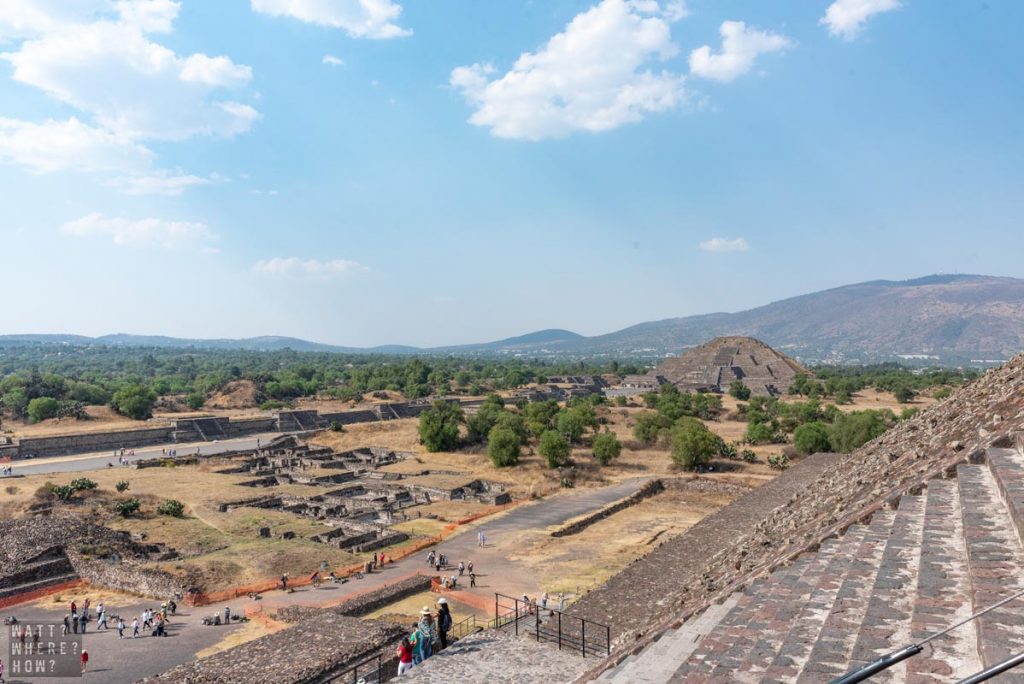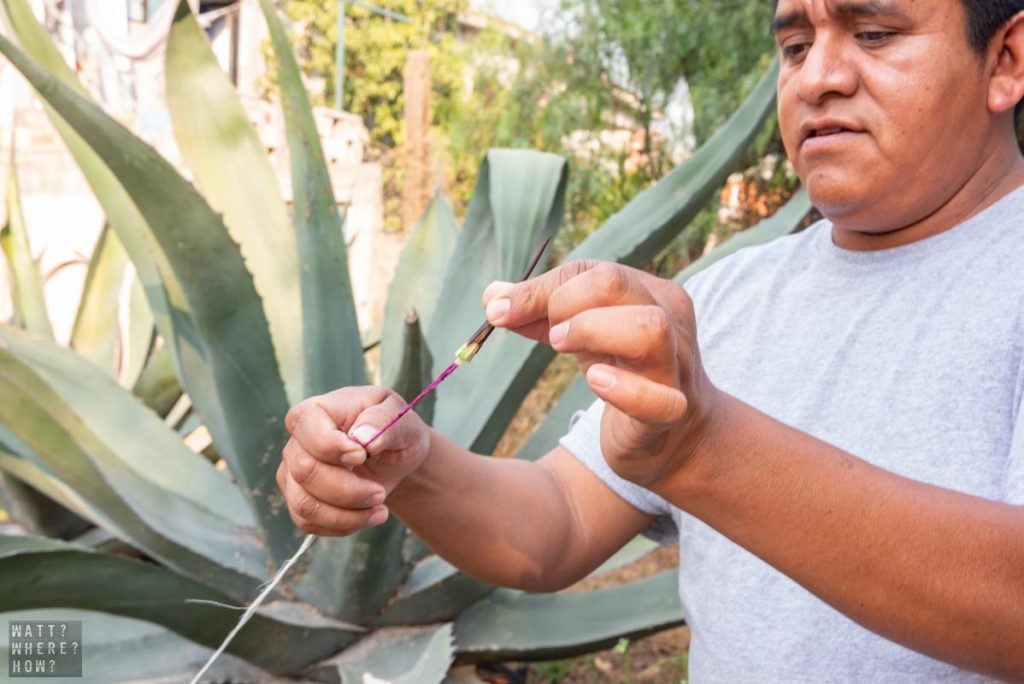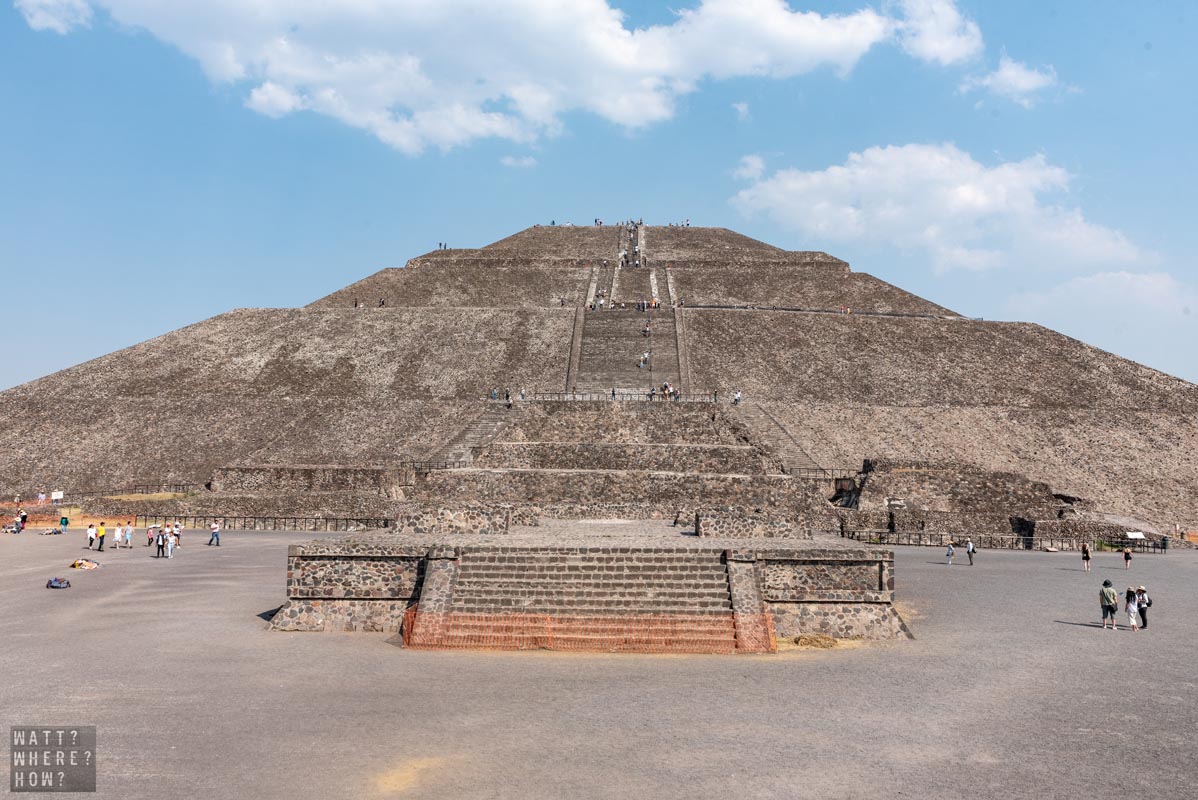What you should know before you go from Mexico City to Teotihuacan.
It’s a name you probably won’t get right no matter how many times you try. But it’s not just the name you’ll struggle with. Everything you think you know about Teotihuacan is wrong. The site isn’t Mayan. The ruins aren’t Inca. They aren’t even Aztec. They aren’t Pyramids; they are temples. You’ll need to take a tour to be re-educated and you won’t regret it.
The most direct and easiest way to go from Mexico City to Teotihuacan is to hire a car. There are myriad of tour options that will take in the temple complex, with additional upgrades like having dinner at the cavern adjacent, or riding quad bikes in the area. If you want to do it cheap, get a bus from the Autobuses Del Norte bus station in Northern Mexico City for between $5 and $10.

What to take with you
Before you go, be prepared for a long, hot day. Wear long-sleeved shirts that feature moisture wicking, or super hot weather-friendly clothes. You don’t need hiking boots, but wear sensible shoes with good grip as the temple steps are steep and worn. Bring water bottles or a Camelpak. At the entrances, there are souvenir shops with public restrooms, shops with bottled water, and popsicles to help you cool down – and plenty of cheap souvenirs. If you want it to be a cheap day, bring a packed lunch in a cooler bag. Don’t forget your sunscreen and a wide-brimmed hat and sunglasses.
The first great city in the Americas
Teotihuacan is one of the great ancient cities, existing chiefly between 100 B.C. and A.D. 650. First instinct is to think that it’s an Aztec or Mayan site, but it was built by the Teotihuacan people a thousand years before the Aztecs took it over.

The sprawling city originally spread over 21 square kilometers though much of that has been lost to time. Now a central section is recognized as the main city with other structures yet to be revealed. Active excavations onsite are coming up with more answers as the years progress, and just ten years ago a complex of tunnels and sacrificial implements were found under one of the smaller temples. Additional digs beneath the Temple of the Moon have found human and animal sacrifices on each level with evidence of decapitations.

Step back 1500 years
Entry to the complex is through one of five gates. There are restaurants, bars, souvenir shops and tour buses along the way, but it’s not as intense as our visit to Chichen Itza, which felt surreal in its overt commercialization. If you don’t have sunscreen and a wide brim hat, you should probably grab one on the way in as there’s little to no protection from the beating sun. Bottled waters and ice cold paletas (Mexican popsicles) will also provide a soothing adjustment stepping out into the heat from an air-conditioned car or coach.

Our tour starts at the Palace of the Jaguars, a ruin rebuilt by Aztecs and again by archeologists. Most of the rooms have been reconstructed, with pebbles in the concrete indicating what isn’t original (which is most of this structure). Ancient paintings of jaguars blowing feathered conch shells that drip with blood symbolize war. Internal rooms feature colorful paintings of birds. If the fluorescent lighting was replaced with flaming torches, we swear it would feel like a scene from an Indiana Jones movie.
Emerging back out of the palace we’re greeted with a full vista of the city. Mounds of little more than rubble dictate the presence of an ancient structure though most are covered with cacti and thick brown grasses. Two key temples rise up – the Temple of the Sun and the Temple of the Moon.
There’s a constant blood-curdling growl echoing off the stone structures. Local merchants are the source of this curiosity. They are selling ocarina-like whistles that emit what represents the roar of the jaguar. It’s a sound you will hear in historical ruins across Central America and we’re momentarily tempted to get one just to mess with our kitty back home – but we’re not that cruel.

The Avenue of the Dead
A central boulevard named the Avenue of the Dead extends 2.4km between the two main structures and beyond, with smaller ruins dotting either side of the road. The smaller of the two, the Temple of the Moon looks like the better option to climb, being less than half the size of the main temple at 63m/200FT. Each step is far more challenging when you start your climb. A flimsy rope serves as a banister but the easiest way to attack the climb is by stepping diagonally. Affected by both mild altitude sickness and gastro the ascent is harder than we imagined but once at the main sacrificial platform, we’re rewarded with sweeping panoramic views of the complex.



Emboldened by our ability to traverse the smaller temple without dying, we strike out towards the iconic Temple of the Sun, built to get the Teotihuacáns closer to the heavens. Climbing this temple is much more of a commitment at 225m/730FT tall. Thankfully there are frequent platforms to rest and recover composure. In peak seasons the temple has to be traffic controlled with ropes dictating areas crowds have to wait to manage the number of people on the steep and narrow steps. For us, the day is hot and crowds sparse, so the only restriction is our lack of fitness and the aforementioned maladies.

Taking in a God’s eye view
The view from the top is as epic as the ceremonies and sacrifices that have taken place right where we’ve been standing. To one side, the smaller Temple of the Feathered Serpent looks relatively insignificant, yet it has been a hive of archeological discoveries in recent years. It’s well worth spending a good twenty minutes admiring the view and catching your breath before descending. You will work muscles that haven’t been challenged in years. Wear comfortable, hardy footwear as it’s rough-hewn, and the rocks are quite sharp.


We head off late afternoon and a new wave of tour buses is arriving. After dark, the city comes alive with a vibrant sound and light spectacular, alas we have places to go and people to see.

San Francisco Mazapa
We drive to the nearest township of San Francisco Mazapa. Here the streets bear the colorful bunting and streamers of the annual feast day of St. Francis that takes place each October. The decorations are maintained throughout the year adding a festive touch to the golden glow of the afternoon sun.
Home made experiences
Tours have an annoying habit of including a purposeful detour to an artisan as a thinly veiled hard sell. Thankfully our small group tour with Intrepid handles this differently. Instead of going to a dirty warehouse showroom, we head to a local family’s house.
Fearing the worse, we steel ourselves for a disingenuous sales pitch. Instead, we are invited into the back yard of a small bungalow. A very basic shed houses stone cutting and polishing equipment and a trampoline and toys offer evidence of regular family life. Our host is a gregarious, smiling Mexican man in his forties. He shares the history of his culture through the use of the Agave cactus, something that is used for paper, pigment, needle, thread, and of course, alcohol.


Rather than a hard sell on the obsidian he crafts meticulously, he just chooses pieces with meaning and shows examples of the different stone finishes that bring out swirls and sparkles. There’s no talk about buying now. It’s refreshing.

Equally refreshing is the offer of a happy hour. His family produces their own Pulque – sweet alcohol that comes from the agave. Rather than being smoked and distilled, it is momentarily fermented to create a tangy cactus cider, a drink that dates back to the Mayans. Palette teased, we are then taught the gentle art of sipping tequila and mezcal rather than lick-sip-suck slamming. We discover a new appreciation for the nuanced flavors, though prefer the smokiness of the mezcal over the sharper tequila.

As we are sampling the drinks, the family appear along with three collies. They all help the father with clearing the glasses and then man a small shop in their shed, where the best pieces of carved obsidian are available for purchase. It’s the first time we have experienced a non-pushy tour sell and it motivates us to want to support this charming man and his family.
A Mexican Family Dinner
Touted as a family dinner with locals, our final stop delivers on the plate but not in the experience department. A modern, quite well-to-do home is the base for local adventure tours on quad bikes and it looks like they do quite well from small group excursions. There would have to be 20 quad bikes parked in garages, and evidence of other amenities. But we’re here to dine, not to ride.

It’s like going to someone’s house for a backyard barbecue and they hide the whole time except when they come out with another course. The described family experience is more just a chance to dine like a family rather than with a family. After spending the day on a bus, our immediate “family” impresses with boisterous conversations that range from travel tips to political discourses.

The food hits the mark too, with a squash blossom soup and chicken flautas as the main entree with the requisite beans and rice, the staples of Central American cuisine.

Returning to Mexico City via the freeways we experience an unexpected exchange at the toll booths. A gang of local farmers has staged a financial intervention, insisting on collecting tolls for the people of the area, not the government. There is a threatening undertone to the negotiations and enough in the gang to cause a fuss but gladly they accept the toll and let the van through. We never feel endangered but it’s another experience that reveals so much about the spirit of the people.

WHAT?
Teotihuacan is an essential Mexican travel experience, giving you a first hand look at a wonder of the world.
WHERE?
Teotihuacan is about 40 kilometers north east of Mexico City.
HOW?
Intrepid is an Australian Company with a great grass roots ethos. They offer small group travel using public transport or vans to get a genuine taste for the location. We took the Intrepid Urban Adventures Teotihuacan Day Trip for $46 including dinner.




















